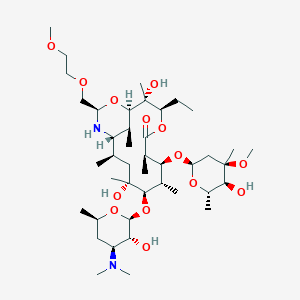| 1 |
Natural products as sources of new drugs over the last 25 years. J Nat Prod. 2007 Mar;70(3):461-77.
|
| 2 |
Trend Analysis of a Database of Intravenous Pharmacokinetic Parameters in Humans for 1352 Drug Compounds
|
| 3 |
Review of macrolides and ketolides: focus on respiratory tract infections. Drugs. 2001;61(4):443-98.
|
| 4 |
Arginine-482 is not essential for transport of antibiotics, primary bile acids and unconjugated sterols by the human breast cancer resistance protein (ABCG2). Biochem J. 2005 Jan 15;385(Pt 2):419-26.
|
| 5 |
Drug-Drug interactions of clinical significance in the treatment of patients with Mycobacterium avium complex disease. Clin Pharmacokinet. 2000 Sep;39(3):203-14.
|
| 6 |
Expression levels and activation of a PXR variant are directly related to drug resistance in osteosarcoma cell lines. Cancer. 2007 Mar 1;109(5):957-65.
|
| 7 |
Contribution of human hepatic cytochrome P450 isoforms to regioselective hydroxylation of steroid hormones. Xenobiotica. 1998 Jun;28(6):539-47.
|
| 8 |
Comprehensive evaluation of tamoxifen sequential biotransformation by the human cytochrome P450 system in vitro: prominent roles for CYP3A and CYP2D6. J Pharmacol Exp Ther. 2004 Sep;310(3):1062-75.
|
| 9 |
Isoform-specific regulation of cytochromes P450 expression by estradiol and progesterone. Drug Metab Dispos. 2013 Feb;41(2):263-9.
|
| 10 |
Metabolic interactions between acetaminophen (paracetamol) and two flavonoids, luteolin and quercetin, through in-vitro inhibition studies. J Pharm Pharmacol. 2017 Dec;69(12):1762-1772.
|
| 11 |
Potent mechanism-based inhibition of CYP3A4 by imatinib explains its liability to interact with CYP3A4 substrates. Br J Pharmacol. 2012 Apr;165(8):2787-98.
|
| 12 |
Effects of morin on the pharmacokinetics of etoposide in rats. Biopharm Drug Dispos. 2007 Apr;28(3):151-6.
|
| 13 |
The metabolism of zidovudine by human liver microsomes in vitro: formation of 3'-amino-3'-deoxythymidine. Biochem Pharmacol. 1994 Jul 19;48(2):267-76.
|
| 14 |
Substrates, inducers, inhibitors and structure-activity relationships of human Cytochrome P450 2C9 and implications in drug development. Curr Med Chem. 2009;16(27):3480-675.
|
| 15 |
Doxorubicin transport by RALBP1 and ABCG2 in lung and breast cancer. Int J Oncol. 2007 Mar;30(3):717-25.
|
| 16 |
Wild-type breast cancer resistance protein (BCRP/ABCG2) is a methotrexate polyglutamate transporter. Cancer Res. 2003 Sep 1;63(17):5538-43.
|
| 17 |
The effect of low pH on breast cancer resistance protein (ABCG2)-mediated transport of methotrexate, 7-hydroxymethotrexate, methotrexate diglutamate, folic acid, mitoxantrone, topotecan, and resveratrol in in vitro drug transport models. Mol Pharmacol. 2007 Jan;71(1):240-9.
|
| 18 |
Role of BCRP as a biomarker for predicting resistance to 5-fluorouracil in breast cancer. Cancer Chemother Pharmacol. 2009 May;63(6):1103-10.
|
| 19 |
Inhibiting the function of ABCB1 and ABCG2 by the EGFR tyrosine kinase inhibitor AG1478. Biochem Pharmacol. 2009 Mar 1;77(5):781-93.
|
| 20 |
Sterol transport by the human breast cancer resistance protein (ABCG2) expressed in Lactococcus lactis. J Biol Chem. 2003 Jun 6;278(23):20645-51.
|
| 21 |
The phytoestrogen genistein enhances multidrug resistance in breast cancer cell lines by translational regulation of ABC transporters. Cancer Lett. 2016 Jun 28;376(1):165-72.
|
| 22 |
Curcumin inhibits the activity of ABCG2/BCRP1, a multidrug resistance-linked ABC drug transporter in mice. Pharm Res. 2009 Feb;26(2):480-7.
|
| 23 |
Imatinib mesylate (STI571) is a substrate for the breast cancer resistance protein (BCRP)/ABCG2 drug pump. Blood. 2004 Nov 1;104(9):2940-2.
|
| 24 |
A synthetic alanyl-initiator tRNA with initiator tRNA properties as determined by fluorescence measurements: comparison to a synthetic alanyl-elongator tRNA. Nucleic Acids Res. 1991 Oct 25;19(20):5749-54.
|
| 25 |
An examination of the differential sensitivity to ketolide antibiotics in ermB strains of Streptococcus pyogenes and Streptococcus pneumoniae. Curr Microbiol. 2004 Oct;49(4):239-47.
|
| 26 |
Structural basis for the interaction of antibiotics with the peptidyl transferase centre in eubacteria. Nature. 2001 Oct 25;413(6858):814-21.
|
| 27 |
The ChEMBL database in 2017. Nucleic Acids Res. 2017 Jan 4;45(D1):D945-D954.
|
| 28 |
Depression of colony formation by human thymus-derived lymphocytes with rifampin and other antimicrobial agents. J Infect Dis. 1981 Jun;143(6):832-5.
|
| 29 |
Retapamulin inhibition of translation and 50S ribosomal subunit formation in Staphylococcus aureus cells. Antimicrob Agents Chemother. 2007 Sep;51(9):3385-7.
|
| 30 |
The streptogramin antibiotics: update on their mechanism of action. Expert Opin Investig Drugs. 1998 Apr;7(4):591-9.
|
| 31 |
2014 FDA drug approvals. Nat Rev Drug Discov. 2015 Feb;14(2):77-81.
|
| 32 |
The protein synthesis inhibitors, oxazolidinones and chloramphenicol, cause extensive translational inaccuracy in vivo. J Mol Biol. 2002 Sep 13;322(2):273-9.
|
|
|
|
|
|
|




